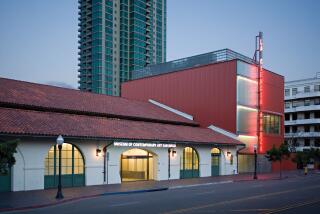Petersen Automotive Museum takes a major detour
One by one, in auctions across the country, some of the world’s most collectible cars are quietly passing from the Petersen Automotive Museum’s vault into private hands.
The sales started in March, and they include the automotive equivalents of a Pablo Picasso or a Salvador Dali. A 1995 Ferrari F50 went for $1.375 million. A 2006 Bugatti Veyron — the first sold in the U.S. — fetched $924,000. A 1990 Ferrari F40 garnered $715,000.
Before the auctions end, the museum plans to liquidate nearly a third of its cache of about 400 classic cars. The sales — conducted under the radar until the museum confirmed them to The Times on Monday — will raise money to finance a major face-lift and reconfiguration of the institution, which occupies a former Ohrbach’s department store at Wilshire Boulevard and Fairfax Avenue.
PHOTOS: A tour through Petersen’s vault of rare cars
The new plans include a greater emphasis on motorcycles and French art deco vehicles, passions that match the tastes of the museum’s new leadership. The strategy was launched this year by Executive Director Terry Karges — who owns a motorcycle company, Champions Moto — and new board Chairman Peter Mullin, who also heads an auto museum in Oxnard that boasts one of the world’s foremost private collections of French cars.
“The idea was to breathe some life into the museum,” Karges said. “We want to be a world-class automotive museum. We want to become an art museum featuring rolling sculpture and tell stories about the art of speed and the art of design.”
The auctions were kept low-profile because of worries about how the news might affect future automobile donations, Karges said.
The sell-off has drawn criticism from former Petersen employees. The overhaul, they say, threatens to move the institution from the focus put forth in its mission statement: “to present the history of the automobile and its impact on American life and culture using Los Angeles as the prime example.”
Founded in 1994 by Robert E. Petersen, head of a publishing empire that included Motor Trend magazine, the museum has until now focused on vehicles built or designed in Southern California.
“They have sold a lot of wonderful cars that Bob Petersen was very fond of,” said Buddy Pepp, who retired as the museum’s executive director last year.
The California-focused collection helped establish the Petersen as one of the premier automotive museums in the nation, said Matt Anderson, curator of transportation at Henry Ford Museum in Dearborn, Mich.
“They have a signature collection,” Anderson said, “some rare, one-of-a-kind vehicles, some Hollywood movie cars and then a good cross representation that fits Southern California’s car culture, which may be even more significant than that of Detroit.”
So far, the Petersen has sold 12 cars for a combined $8.5 million at Gooding & Co.’s Amelia Island Auction in March. An additional 107 cars will be offered at an Auctions America event in Burbank starting Aug. 1. They include a 1999 Shelby Series 1 that bears serial number 00075, in honor of designer Carroll Shelby’s 75th birthday, and a 1963 Volkswagen Beetle — “Herbie” — that starred in Disney’s 1968 movie “The Love Bug.”
Karges estimates that the August auction could reap as much as $5 million for the museum.
Karges, who became executive director last year, called the sales a culling of vehicles that were either surplus or that could easily be borrowed from collectors if needed for an exhibit. He said the sales will provide millions of dollars to fund improvements to the museum, including new exhibits and interactive displays, in time for its 20th anniversary next year.
He said the museum will bring in some of the cars from Mullin’s French collection and will add more about motorcycles, technology and motor sports.
Including Mullin, three of the six members of the Petersen’s board are also on the board of the Mullin Automotive Museum in Oxnard. Mullin personally owns almost all the rare pre-World War II French cars displayed at his museum.
Selling the vehicles won’t hurt the Petersen because many were not exhibit-quality cars. Others would cost “an enormous” amount to restore and were taking up valuable space, Karges said.
“There are so many cars, there is no room to move downstairs,” Karges said, referring to the Petersen’s vault, or storage area.
With freed-up space, the museum may still add cars to its collection. Karges also plans to expand its already extensive collection of alternative-fuel vehicles.
Once restricted to high-ranking museum personnel and visiting VIPs, the vault was opened to public tours last year and has become a popular and profitable exhibit. For $25 on top of the Petersen’s $15 admission, visitors can take a guided tour to learn the stories behind about 130 cars, most of which are linked to Hollywood stars and other notables.
Pepp, the former director, questioned whether the Petersen could continue to borrow the kind of rare and prized cars it’s selling now. Those cars could well disappear into overseas collections, he said.
No one from the Petersen family is around to weigh in. Petersen and his wife, Margie, had two sons, Bob and Ritchie, who were 10 and 9 when they died in a 1975 airplane crash. So there are no heirs who might request that the museum adhere to its original mission, said Brian Schippert, a former museum intern who later managed private car collections for wealthy individuals.
Schippert became alarmed after seeing about 50 cars he remembered from his time at the Petersen listed for the Auction America sale in Burbank.
“I am concerned they are liquidating so many assets that made up the foundation of the museum,” Schippert said.
Greg Wallace, manager of the General Motors Heritage Center, the automaker’s historic collection in Sterling Heights, Mich., said he was surprised that the Petersen would sell so much of its collection.
Institutions have to cull their fleets from time to time, Wallace said, and what the Petersen faces is “a classic problem for museums. It is tough to keep them relevant, modern and afloat.”
Twitter.com/@LATimesJerry
More to Read
Inside the business of entertainment
The Wide Shot brings you news, analysis and insights on everything from streaming wars to production — and what it all means for the future.
You may occasionally receive promotional content from the Los Angeles Times.










